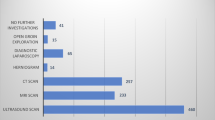Abstract
Background: The study was undertaken in order to assess the degree of concordance between the patient’s and surgeon’s perceptions of adverse events after groin hernia surgery.
Methods: 206 patients who underwent elective surgery for groin hernia at Samariterhemmet, Uppsala, Sweden in 2003 were invited to a follow-up visit after 3–6 weeks. At this visit the patient was instructed to answer a questionnaire including 12 questions concerning postoperative complications. A postoperative history was taken and a clinical examination performed by a surgeon who was not present at the operation and did not know the outcome of the questionnaire. All complications noted by the physician were recorded for corresponding questions in the questionnaire.
Results: 174 (84.5%) patients attended the follow up, 161 men and 13 women. A total of 190 complications were revealed by the questionnaire, 32 of which had caused the patient to seek help from the health-care system. There were 131 complications registered as a result of the follow-up clinical examinations and history. Kappa levels ranged from 0.11 for urinary complications to 0.56 for constipation.
Conclusion: In general, the concordance was poor. These results emphasise the importance of providing detailed information about the usual postoperative course prior to the operation. Whereas the surgeon, from a professional point of view, has a better idea about what should be expected in the postoperative period and how any complications should be categorised, only the patient has a complete picture of the symptoms and adverse events. This makes it impossible to reach complete agreement between the patient’s and surgeon’s perceptions of complications, even under the most ideal circumstances.

Similar content being viewed by others
References
Nilsson E, Haapaniemi S, Gruber G, Sandblom G (1998) Methods of repair and risk for reoperation in Swedish hernia surgery from 1992 to 1996. Brit J Surg 85:1686–1691
Sandblom G, Gruber G, Kald A, Nilsson E (2000) Audit and recurrence rates after hernia surgery. Eur J Surg 166:154–158
Nilsson E, Haapaniemi S (1998) Hernia registers and specialization. Surg Clin North Am 78:1141–1155
Haapaniemi S, Nilsson E (2002) Recurrence and pain three years after groin hernia repair. Validation of postal questionnaire and selective physical examination as a method of follow-up. Eur J Surg 168:22–28
Sandblom G, Haapaniemi S, Nilsson E (1999) Femoral hernias: a register analysis of 588 repairs. Hernia 3:131–134
Gunnarsson U (2003) Quality assurance in surgical oncology—colorectal cancer as an example. Eur J Surg Oncol 29:89–94
Gunnarsson U, Heuman R (1999) Patient experience ratings in surgery for recurrent hernia. Hernia 3:69–73
Armitage P, Berry G (1994) Further analysis of categorical data. In: Armitage P, Berry G (eds) Statistical methods in medical research. Blackwell Science, Oxford, pp 443–7
Durieux P, Bissery A, Dubois S, Gasquet I, Coste J (2004) Comparison of health care professionals’ self-assessments of standards of care and patients’ opinions on the care they received in hospital: observational study. Qual Saf Health Care 13:198–202
Lawrence K, McWhinnie D, Goodwin A, Doll H, Gordon A, Gray A, Britton J, Collin J (1995) Randomized controlled trial of laparoscopic versus open repair of inguinal hernia: early results. Brit Med J 311:981–985
Kald A, Nilsson E (1991) Quality assessment in hernia surgery. Qual Assur Health Care 3:205–210
McManus PL, Wheatley KE (2003) Consent and complications: risk disclosure varies widely between individual surgeons. Ann Roy Coll Surg 85:79–82
Gilbert AI (1993) Medical/legal aspects of hernia surgery. Personal risk management. Surg Clin North Am 73:583–593
Ragab AA (2003) Validity of self-assessment outcome questionnaires: patient-physician discrepancy in outcome interpretation. Biomed Sci Instrum 39:579–584
Gunnarsson U, Heuman R, Wendel-Hansen V (1996) Patient evaluation of routines in ambulatory hernia surgery. Ambulat Surg 4:11–13
Bonsanto MM, Hamer J, Tronnier V, Kunze S (2001) A complication conference for internal quality control at the Neurosurgical Department of the University of Heidelberg. Acta Neurochir (Wien) 78:139–145
Herbert MA, Prince SL, Williams JL, Magee MJ, Mack MJ (2004) Are unaudited records from an outcomes registry database accurate? Ann Thorac Surg 77:1960–1964
Hanto DW (2003) Reliability of voluntary and compulsory databases and registries in the United States. Transplantation 75:2162–2164
Wynn A, Wise M, Wright MJ, Rafaat A, Wang YZ, Steeb G, McSwain N, Beuchter KJ, Hunt JP (2001) Accuracy of administrative and trauma registry databases. J Trauma 51:464–468
Gunnarsson U, Seligsohn E, Jestin P, Pahlman L (2003) Registration and validity of surgical complications in colorectal cancer surgery. Brit J Surg 90:454–459
Dreisler E, Schou L, Adamsen S (2001) Completeness and accuracy of voluntary reporting to a national case registry of laparoscopic cholecystectomy. Int J Qual Health Care 13:51–55
Author information
Authors and Affiliations
Corresponding author
About this article
Cite this article
Fränneby, U., Gunnarsson, U., Wollert, S. et al. Discordance between the patient’s and surgeon’s perception of complications following hernia surgery. Hernia 9, 145–149 (2005). https://doi.org/10.1007/s10029-004-0310-x
Received:
Accepted:
Published:
Issue Date:
DOI: https://doi.org/10.1007/s10029-004-0310-x


